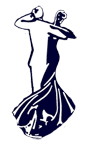 |
ROUND DANCING — CHOREOGRAPHED BALLROOMEDUCATIONAL ARTICLESMAJOR SECTIONS: Figures | Articles | Links | Alph. Index | Search | Home |
|
|
On Body Mechanics Iby Roy & Phyllis Stier Probably the best way to separate a good dancer from a novice is a thing called body mechanics. It is a fairly lengthy set of do's and don'ts which can make a more pleasant dance experience for anyone who wants to put them into practice. Let's start with the normal closed position and check out some considerations that get the project going. Before ever starting to dance, you must analyze the placement of weight — it should be forward on the ball of the foot. Rock back on your heels from this position and see how much space there is between the partnership (not good). Next, the man should hold the lady's right hand in his left so that he can see the back of his hand at about eye level. This may require a little inward twisting of the joined hands to accomplish the desired configuration. The man's right hand should be under the shoulder of the lady — not too far around and pointed somewhat downward in angle with the fingers closed (no banana hands). Professional dancers look like they are cupping their right hand but this is only an illusion because it is necessary to keep a straight wrist. The lady places her left hand on the man's upper arm so that it rests along much of it. She must have a fairly tight fit but without putting much weight on the man's right arm, which he would have to compensate for. We are asking the man to hold this position with his right elbow well out and quite high. This can mean some uncomfortable strain unless the lady cooperates, so do your thing ladies.We don't need to go into the alignment between partner and how to keep contact in the 3 main areas, etc. because this sort of thing has been covered in so many clinics; however, a little on maintaining your "window" would be in order. The lady is called upon to adapt to a head placement more than the man because she must shape more to the left and keep her weight centralized by a compensating right hip that automatically shifts right. Actually, this is not a bad body line to hold because the man will benefit by an increased latitude of dance freedom. The man, or course, will have his own window over the lady's right shoulder, and his maintenance of this while in closed position will facilitate all turns in particular. We usually have to check couples that are new to this body position because the tendency is to emulate what they think they see and get into some really grotesque configurations as a result. Body Movements: When you have mastered the closed position hold as outlined it is most important to retain it, particularly in turns. The good shoulder and arm position where the man maintains his facing to partner is usually referred to as his "back line." This also refers to how the man can handle a more or less rigid hold without actually looking like it is stiff and uncomfortable. The entire body must move in unison. This puts the focus onto the need for lowering onto the supporting foot before driving the body forward as a unit. You must overcome the tendency for the foot to go out first with the body following, a phenomenon known as "scoop dancing." It takes quite a while to develop a due process format where the arm positions are held as the couple lowers together (with the man telegraphing his movements) and the shaping for turns.
This column comes from a series published in Cue Sheet Magazine between 1987 and 1992, and is reprinted with permission. The full series is collected in an 86-pg booklet, available for $30.00 plus postage. E-mail Fran Kropf at cutecuer@cox.net. This article was published in the Dixie Round Dance Council (DRDC) Newsletter, July 2009.
|
 |
|
|
Page last revised